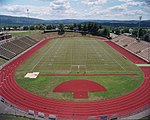Allegany College of Maryland
1961 establishments in MarylandAllegany College of MarylandBuildings and structures in Cumberland, MarylandCommunity and junior colleges in MarylandEducational institutions established in 1961 ... and 5 more
NJCAA athleticsNursing educationUniversities and colleges in Allegany County, MarylandUniversities and colleges of Cumberland, MD-WV-PAUse mdy dates from April 2023
Allegany College of Maryland (or ACM) is a public community college in Cumberland, Maryland. It was previously known as Allegany Community College. The college was founded in 1961 and is accredited by the Middle State Commission on Higher Education. The college offers 31 two-year degree programs, 30 certificate programs, and 10 letters of recognitions. The college also has campuses and extension sites in Cumberland, Maryland; Everett, Pennsylvania; Oakland, Maryland; Somerset, Pennsylvania; and LaVale, Maryland.
Excerpt from the Wikipedia article Allegany College of Maryland (License: CC BY-SA 3.0, Authors).Allegany College of Maryland
Willowbrook Road Southeast, Cumberland
Geographical coordinates (GPS) Address External links Nearby Places Show on map
Geographical coordinates (GPS)
| Latitude | Longitude |
|---|---|
| N 39.652777777778 ° | E -78.729166666667 ° |
Address
Allegany College of Maryland
Willowbrook Road Southeast
21502 Cumberland
Maryland, United States
Open on Google Maps




